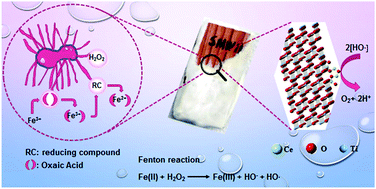Non-biocidal preservation of wood against brown-rot fungi with a TiO2/Ce xerogel†
Abstract
The use of wood as an eco-friendly building material requires the development of environmentally benign wood preservatives, which are ideally non-toxic during and after the service life. However, too little is known about the protection of wood against wood decay fungi using non-biocidal methods, and as a result, simple but effective methods that increase the service life without environmental or health risks are still rare. A novel wood protection method is described that is based on a titanium isopropoxide gel, and cerium(IV) ammonium nitrate, as a stabilizer for the treatment of wood. The hydrolysis of titanium isopropoxide is initiated by the OH-groups of wood, as well as the moisture in the wood cell wall, and subsequently results in a cerium-doped TiO2 layer, which not only seals the wood surface from direct exposure to hydrolytic enzymes but also occludes the micro/nano-pores of the wood cells. The cerium dopant acts as a radical scavenger that quenches the hydroxyl radicals in the initial stage. Our studies revealed that Norway spruce wood can be better protected against wood decay by Gloeophyllum trabeum, Rhodonia placenta and Coniophora puteana. The TiO2/Ce xerogel coating also improves resistance against weathering, as modified specimens showed good anti-fungal properties even after accelerated weathering treatments. This novel wood protection method provides a greener and safer alternative to traditional biocidal wood preservatives and has the potential to extend the service life of wood materials particularly in outdoor applications as well as for archaeological wood conservation.



 Please wait while we load your content...
Please wait while we load your content...